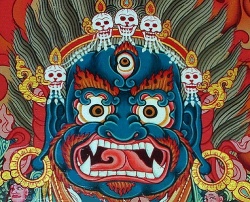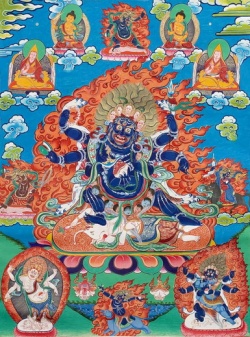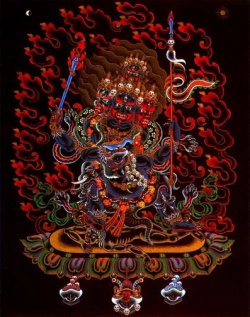Mahākāla
Mahākāla (Sanskrit) is a Dharmapala ("protector of Dharma") in Vajrayana Buddhism, and a deity in Chinese and Japanese Buddhism, particularly in The Vajrayana school. He is known as Daheitian (大黑天) in Chinese and Daikokuten (大黒天) in Japanese. Mahākāla belongs to the fourth hierarchy of deities.
In Hinduism, Mahakala is a name of Shiva (as, for example, at the Shiva temple in Ujjain that is more than once mentioned by Kālidāsa), but it is also a name of one of his principal attendants (Sanskrit: gaṇa): along with Nandi, which is one of Shiva's watchmen, and so is often represented outside the main doorway of early North Indian temples.
Name
Mahakala is relied upon in all schools of Tibetan Buddhism and is depicted in a number of variations, each with distinctly different qualities and aspects. He is also regarded as the emanation of different beings in different cases, though he is best known as a wrathful manifestation of Avalokiteshvara, the Bodhisattva of Compassion. He is a Dharmapala (Dharma Protector) and one of the eight main Dharmapalas, alongside Yama, Yamantaka, Hayagriva, Vaisravana, Palden Lhamo, Tshangspa Dkarpo, and Begste.
Mahakala is typically black in color. Just as all colors are absorbed and dissolved into black, all names and forms are said to melt into those of Mahakala, symbolizing his all-embracing, comprehensive nature. Black can also represent the total absence of color, and again in this case it signifies the nature of Mahakala as ultimate or absolute reality.
Mahakala is almost always depicted with a crown of five skulls, which represent the five Wisdom.
The most notable variation in Mahakala's manifestations and depictions is in the number of arms, but other details can vary as well. For instance, in some cases there are Mahakalas in white, with multiple heads, without genitals, standing on varying numbers of various things, holding various implements, with alternative adornments, and so on.
In Hinduism, Mahakala is a name of Shiva (Great Time), but is also the name of one of Shiva's principal attendents, or ganas. He is also one of Shiva's watchmen, along with Nandi.
In Japan he is called Daikokuten and is one of the Seven Lucky Gods. In this incarnation, he is suprisingly less violent and is more benevolent towards humans. He is also associated with the Shinto God Okuninushi and Dakiniten is also associated with him.
His Art in Shin Megami Tensei might be based off of the Six-Armed aspect of Mahakala, or Sanmen Daikoku, a sword-wielding guardian aspect of Daikokuten with three heads and six arms.
Mahākāla is a Sanskrit bahuvrihi of mahā (महत्; "great") and kāla (काल; "black"). The literal Tibetan translation is "Nagpo Chenpo" (Tibetan: ནག་པོ་ཆེན་པོ།) though, when referring to this deity, Tibetans usually use the word "Goinbo" (མགོན་པོ།—the translation of the Sanskrit word Nāth meaning "Lord" or "protector") instead.
Description
Mahākāla is relied upon in all schools of Tibetan Buddhism. However, he is depicted in a number of variations, each with distinctly different qualities and aspects. He is also regarded as the emanation of different beings in different cases, namely Avalokiteshvara (Tib: spyan ras gzigs) or Chakrasamvara (Tib: Korlo Demchog, Wylie: ’khor lo bde mchog).
Mahākāla is typically black in color. Just as all colors are absorbed and dissolved into black, all names and forms are said to melt into those of Mahakala, symbolizing his all-embracing, comprehensive nature. Black can also represent the total absence of color, and again in this case it signifies the nature of Mahakala as ultimate or absolute reality. This principle is known in Sanskrit as "nirguna", beyond all quality and Form, and it is typified by both interpretations.
Mahākāla is almost always depicted with a crown of five skulls, which represent the transmutation of the five Kleshas (negative Afflictions) into The Five Wisdoms.
The most notable variation in Mahākāla's manifestations and depictions is in the number of arms, but other details can vary as well. For instance, in some cases there are Mahakalas in white, with multiple heads, without genitals, standing on varying numbers of various things, holding various implements, with alternative adornments, and so on.
Manifestations
Six-Armed Mahākāla
Nyingshuk came from Khyungpo Naljor, the founder of the Shangpa Kagyu, and spread to all the lineages—Sakya, Nyingma, and Geluk, as well as various Kagyu lineages. There are also Terma lineages of various forms of Six Armed Mahākāla. Nyinghsuk, though derived from the Shangpa, is not the major Shangpa one—it's in a Dancing posture, rather than standing straight up, and is a very advanced Mahakala practice.
There is also a White Six-Armed Mahakala (Skt: Shad-bhuja Sita Mahakala; Tib. Wylie: mGon po yid bzhin nor bu) popular among Mongolian Gelugpas.
Four-Armed Mahākāla
Various Four-armed Mahākālas (Skt. Chatur-bhuja Mahākāla, Tib. Wylie: mGon po phyag bzhi pa) are the primary Protectors of the Karma Kagyu, Drikung Kagyu and the Drukpa Lineage of Tibetan Buddhism. A four-armed Mahākāla is also found in the Nyingma school, although the primary protector of the Great Perfection (Skt: Mahasandhi, Tib. Dzogchen) teachings which are the pinnacle of the Nyingma system which.
Two-Armed Mahākālas
The two-armed Mahākāla called Bernakchen (Black Coat) is a protector of the Karma Kagyu school, although he derives from Nyingma Terma and was adopted by the Karma Kagyu during the time of 2nd Karmapa, Karma Pakshi. He is often depicted with his consort Rangjung Gyalmo. (He is often Thought to be the primary protector, but he is actually the main protector of the Karmapas specifically. Mahākāla Chakshipa, a four-armed Mahakala, is technically the primary protector. Chakdrupa, a six-armed Mahakala, is also common in the Kagyu.)
Panjaranatha Mahākāla, "Lord of Charms" or "Lord of the Pavilion", an emanation of Manjushri is a protector of the Sakya order.
Mahākāla in Japan
Japanese Daikokuten
Mahākāla (known as Daikokuten 大黑天) enjoys an exalted position as a household deity in Japan, as he is one of the Seven Lucky Gods in Japanese folklore. Mahākāla's association with Wealth and prosperity gave rise to a strange custom known as Fuku-nusubi. This custom started with the belief that one who stole divine figures (gods and goddesses) was assured of good Fortune, if not caught in the act of stealing. In the course of time, stealing of divine images became so common a practice in Japan that the Toshi-no-ichi or the ‘year-end-market’ held in the Asakusa Kannon temple became the main venue of the sale and disposal of such images by the Fortune-seekers. Many small stalls were opened where articles including images of Mahakala were sold on the eve of New Year celebrations.
The Japanese also use the Symbol of Mahākāla as a monogram. The traditional pilgrims climbing the holy Mount Ontake wear tenugui on white Japanese scarves with the Sanskrit seed syllable of Mahākāla.
In Japan, this deity is variously considered to be the God of Wealth, or of the household, particularly the kitchen. He is recognised by his wide face, smile, and a flat black hat, in stark contrast to the fierce imagery portrayed in Tibetan Buddhist Art. He is often portrayed holding a golden mallet, otherwise known as a magic money mallet, and is seen seated on bales of rice, with mice nearby (mice signify plentiful Food).
Interpreting the Symbolism
Khenpo Karthar reminds us ("Relating to the Mahakala Practice," Densal:
"Mahakala is seen standing on the corpse of two human bodies, thus symbolizing the death of negativities and the complete uprooting of negative patterns to such a point that, like a dead body, they will not come to life.
It is very important that we know these symbols of Mahakala because many times we have mistaken notions that he may be a clinging spirit or harmful, evil being, perhaps even the Lord of Death ready to devour and attack. One would find great difficulty in relating to the various symbols without understanding that our awakened compassion is the essential quality of the being of Mahakala.
Mahakala has never been known to harm one being, even in the slightest manner, because he is constantly benefiting beings through the continuous play of the enlightened mind."
Mahakala is a Protector of all Tibetan Buddhism
The form varies according to the different teaching lineages. For example, there is the two-armed, big-mouthed Mahakala Bernakchen of the Karma Kagyu, the four-armed Mahakala who is protector of the Drikung Kagyu, and six-armed Mahakala of the Gelugpas described below. They are not all wrathful forms of Chenresi [Skt.: Avalokiteshvara] although
"There is an emanation of Avalokiteshvara which arose in the form of Mahakala and this is the Shangpa Kagyu Mahakala with one face and six arms, in a standing posture. This form was later adopted by Tsongkhapa and followers as the main protector of the Gelugpa School.
Mahakalas can arise from various sources namely Vajradhara and the Anuttarayoga Tantras but are not generically Avalokiteshvara."
~ Jeff Watt, Himalayan Art
There is a white one associated with prosperity, and also a eunuch and some feminine forms, but it is incorrectly held that there are 75 variants.
"White" Mahakala.
" . . . the different Mahakalas with various number of arms are not all the same. The Six-Armed version is the emanation of Chenrezig (in association with the head-blowing-up episode) and was originally the specialty of Shangpa Kagyu, but has now been adopted all over; one of the Four-Armed versions is an emanation of C[h]akrasamvara and the main protector of Karma Kagyu; the two-armed Bernakchen, an emanation of Samantabhadra, is actually not the main protector of Karma Kagyu, but rather that of the Karmapas specifically, although there is nothing that says the rest of us cannot also practice on him; the Sakyapa has the two-armed Panjaranatha Mahakala, who probably is an emanation of Manjushri and holds the rod that emanate[s] many Mahakalas.
Like many of the other protectors, one pair[s] up with any one of these Mahakalas as appropriate to their cycle of practice; in other words, one doesn't just pick up a Mahakala out of the blue."
~ BB to the Kagyu email list, June 2002.
Ritual Practice
Students do not generally do practices associated with dharmapalas such as Mahakala until they have completed the Preliminary or Foundation Practices and of course, after receiving the empowerment to do so.
The Sanskrit descriptive name, Mahakala (Great Time or Great Dark One) is also used to refer to Lord Shiva, the Hindu god whose tandava dance sustains, but can also destroy, the universe of appearances, and who is associated with Time, another meaning of kala. [The teaching known as the Kala-chakra or Wheel of Time, is a Buddhist tantric system thought of as the key to reality that unites the universe, time and the breath of life.]
Lama C. Reed says that in the liturgy known as Kha Yig Ma, which is the KTD daily practice, a short (3-page) Chagdrupa is performed incorporating the visualization, torma offering and mantra recitation.
A mid-length, "Tsendring" Mahakala practice is done on the 29th lunar day in KTD's 3-year retreat, and in the afternoon of the first day of the yearly Mahakala drupchen, KTD uses the same brief Chagdrupa liturgy, and that this is one is also a part of the Gyespa (extensive) Mahakala ritual.
At KTD, each of the 3 days of Mahakala Drupchen begin with the Dorje Phagmo self-visualization liturgy followed by the recitation of the Gyespa text, which broadly speaking, is a collection of short visualization/torma offering liturgies and mantras of the central Kamtsang protectors, Bernagchen and consort.
Mahakala Bernakchen
Kubilai Khan succeeded his Buddhist brother Munga, and fearful of the influence of Karma Pakshi, the second Karmapa, had him confined to the Chinese Imperial Palace where he was tied by his beard (among other terrible ordeals.) Karmapa prayed to Mahakala Bernagchen, but "Great Black Cloak" took so long putting on his boots, that by the time he got there, the ordeal had ended. However, as he had been summoned, he was obliged by rules of combat to cleave something with the hook-knife that he held at the ready. The Karmapa therefore had him strike the palace. As a result, there is still a gash somewhere in the Imperial Palace.
There is a version saying the Karmapa struck Mahakala for his tardiness, giving him his swollen face! Consequently, no subsequent Karmapa has ever worn a beard. Origin of Mahakala
The compassion of the red Buddha Amitabha manifested as Avalokiteshvara who took a vow to forgo his own enlightenment until all the realms of samsara had been emptied.
This vow required a renewal of determination, and so with Amitabha's blessing, Avalokiteshvara next assumed a form with eleven heads and a thousand arms. Still he had been unable to benefit even a few beings.
Therefore after reflecting for one whole week, he determined that by assuming a wrathful form he would be able "to subdue the degenerate beings of this Age of Darkness." Also he saw that even beings who practiced Dharma were unable to escape from the Bardo realms (time between rebirths where beings may face great anxiety and terrifying experiences) and he thought that in wrathful form he could also protect them in that way. And lastly, he thought that the beings in this Dark Age were poor and needy, experiencing only suffering after suffering, and that in wrathful form he could provide them an antidote to that suffering so that by simply making the wish (for protection) their needs could be met.
These three motives made his determination even greater than before and so from the heart of Noble Avalokiteshvara emerged a dark blue HUNG syllable that immediately became the Instantaneous Protector of Wisdom, Mahakala.
The foundations of all the Pure Lands shook with six kinds of earthquakes, and the Conquering and Transcending One of Immeasurable Light (Amitabha) and all the other Tathagatas of the ten directions proclaimed with one voice:
"Son of the family, it is well that you have made this resolution. You shall have the empowerment of all the wisdom dakinis. You shall have the strength of the wrathful Yama, Lord of Death. You shall have the mountain spirits, the yakshas, the devils and the demonesses as your messengers. You shall embody the great wrathful empowerments of the Body, Speech, Mind, Qualities and Activity of all the Buddhas throughout the three times."
Ever since, bodhisattva Mahakala is the Dharma (Buddha's Doctrine) Protector of all Buddha fields.
Om, Shri Mahakala Yaksha Betli, hung dsa.
Symbolism of Mahakala in the 6-armed Manifestation:
The Protector's body is midnight blue, symbolic of the changeless Dharmakaya.
His three eyes symbolize his knowledge of the past, present and future, and also the manifestation of the three bodies of Buddha.
The crown adorned with five skulls symbolizes the transformation of the five poisons of anger, desire, ignorance, jealousy and pride into the five wisdoms.
His six arms symbolize the attainment of the six Perfections: generosity, patience, morality, diligence, meditation and wisdom. The kartika or triku [or trigu, pron. tigu] the ritual curved knife, cuts attachment to ego.
The kapila or skull bowl filled with blood symbolizes the subjugation of the maras or evil ones. (An alternate interpretation can be found in other contexts.)
The rosary symbolizes his continuous activity for the benefit of beings.
The damaru or hand-drum symbolizes his power over the dakinis. (Also, different interpretations in other contexts.)
His trident symbolizes his power over the three kayas -- the spheres of desire, form and formlessness. (An alternate interpretation can also be found.)
The lasso binds those who break their vows.
His two feet are the means and the wisdom to accomplish his task. That his left leg is straight and his right leg bent symbolize his accomplishment of the benefit to oneself and to others. He tramples on a vinayaka, to symbolize his destruction and dispersal of great obstacles.
The sun on which he stands symbolizes his illumination of the darkness of ignorance.
His lotus seat symbolizes purity undefiled by samsara.
The surrounding blazing fire symbolizes his activity that consumes neurotic states.
The tiger skin stands for purification of desire; the elephant skin for purification of pride, and the snake, for the purification of anger.
His other ornaments together symbolize that he has all the qualities of a Buddha.
The material about the symbolism of 6-armed Mahakala derives from a Gelugpa sadhana (ritual) of Tara that includes an offering to Mahakala. The whole was produced in Jan. 1994 by Dharma Therapy Trust under Ven. Geshé Damchö Yönten and is available unedited at Lamrim.org.uk


